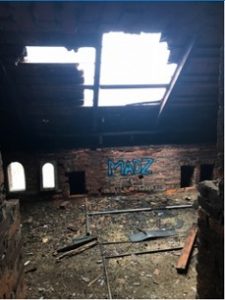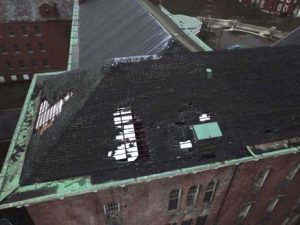News
Holes In Roof Causing Significant Damage To Historic Buildings At The Ridges
By: David Forster
Posted on:
ATHENS, Ohio (WOUB) — Up on a hilltop across the river from Ohio University sits The Ridges, one of the most beloved and iconic landmarks in the Athens area.
Water is leaking through holes in the roof of three of the most historically significant buildings every time it rains or snows, causing serious damage.
The three interconnected buildings form the west wing of the main building, which was the administrative center back when The Ridges was an asylum for the mentally ill.

The state turned The Ridges over to Ohio University in the 1980s and early ’90s. By then many of the buildings that make up the complex were in bad shape.
The original buildings, which date to the mid-1800s, were built to last, with sturdy brick exteriors, thick concrete walls inside and floors covered in durable terrazzo.
But the rafters and roof decking are wood.
The university helped create a master plan for The Ridges years ago and identified the buildings it wanted to use and those that would be marketed to developers to transform into commercial or residential space.
The university has spent millions of dollars rehabilitating the spaces it’s using, including the three buildings that make up the east wing of the central complex. It has also invested in road improvements, electrical upgrades, heating and cooling systems and other infrastructure.
But the three buildings of the west wing have remained largely untouched.
Shawna Bolin, associate vice president for university planning, said the university has a backlog of deferred maintenance on buildings already in use by faculty, staff and students.
“So it’s difficult for us to put money into buildings that we are not planning to occupy,” she said.
The university did spend $300,000 to cover holes in the roof with a massive tarp, a temporary patch intended to last two to three years.

Now, the tarp is deteriorating and holes have formed elsewhere. The roof is in bad shape.
“We’ve actually had some of the decking cave in to give you an idea,” said Steve Wood, the university’s chief facilities management officer. “We have a couple of places where we actually have rafters that have broken through, it’s not just the decking has sagged through.”
Fixing the roof will be expensive. The university has identified several options.
The cheapest option is to patch the old tarp and add another tarp over the new holes. This would cost $650,000 and would not prevent new holes from developing elsewhere on the roof.
Another option would repair damaged rafters and cover the roof in plywood. This would cost $1.1 million and is another short-term fix that would keep the water out for at least a couple of years.
The university has agreed to fund one-third of the cost for either of these temporary fixes. But its preference is a long-term solution that includes a new roof and other repairs expected to last 30 to 40 years.
The cost is $4.5 million.
A new roof would also help with attracting developers because this would be one less expense they would have to absorb.
Athens City Council President Chris Knisely said she was stunned when she first heard about the leaking roof and the cost to repair it. But she said The Ridges is worth the investment. The complex is not just a local landmark but has a cultural significance that extends well beyond the Athens community.

The asylum was one of dozens built around the country in the mid to late 1800s that were modeled on the Kirkbride Plan. This plan was developed by Dr. Thomas Kirkbride, an advocate for a more progressive and humane approach to treating the mentally ill that took root in the 19th century.
Kirkbridge encouraged locating asylums in pastoral settings, with buildings that provided abundant natural light and fresh air. Patients participated in their own care, including working the grounds and in the gardens.
Most of the Kirkbride asylums have long since been demolished or fallen into serious disrepair. The asylums in many cases sat on valuable land that was put to other uses and the old buildings either didn’t fit the new plans or the cost of rehabilitation was considered too high.
The Ridges is among a small number that is still largely intact and still in use.
Knisely said the city doesn’t have the money to fix the roof but is working with the university to identify potential avenues of funding from both government and private sources.
“It’s a challenge,” she said, “but it is a beautiful old building … with contemporary possibilities.”

